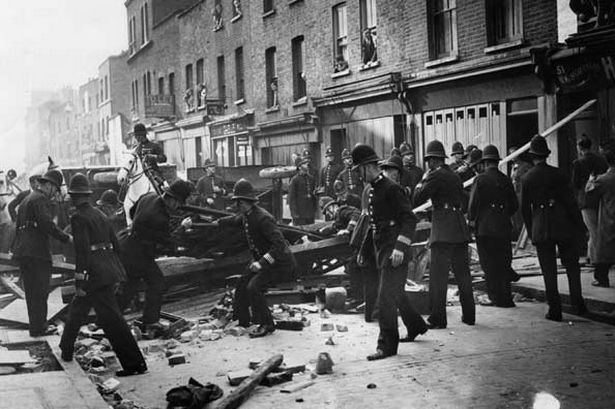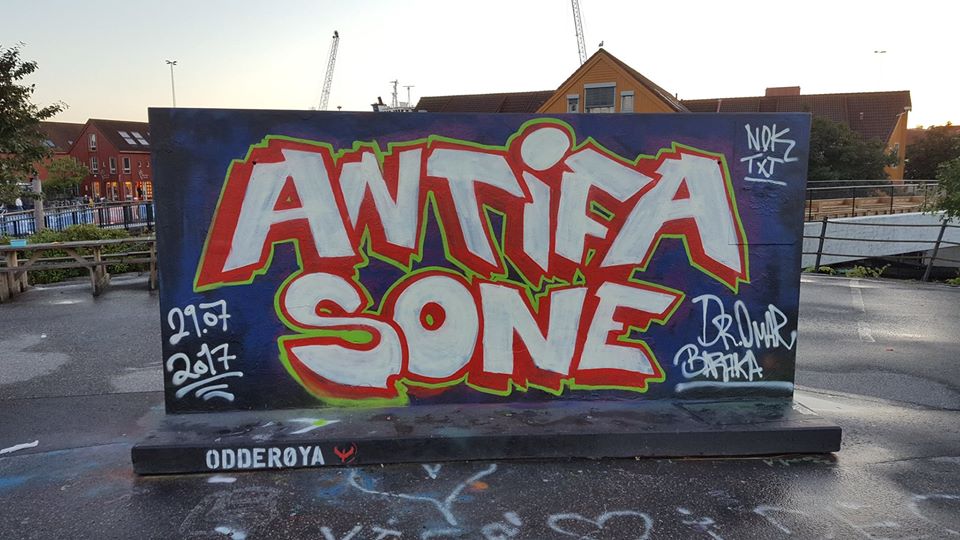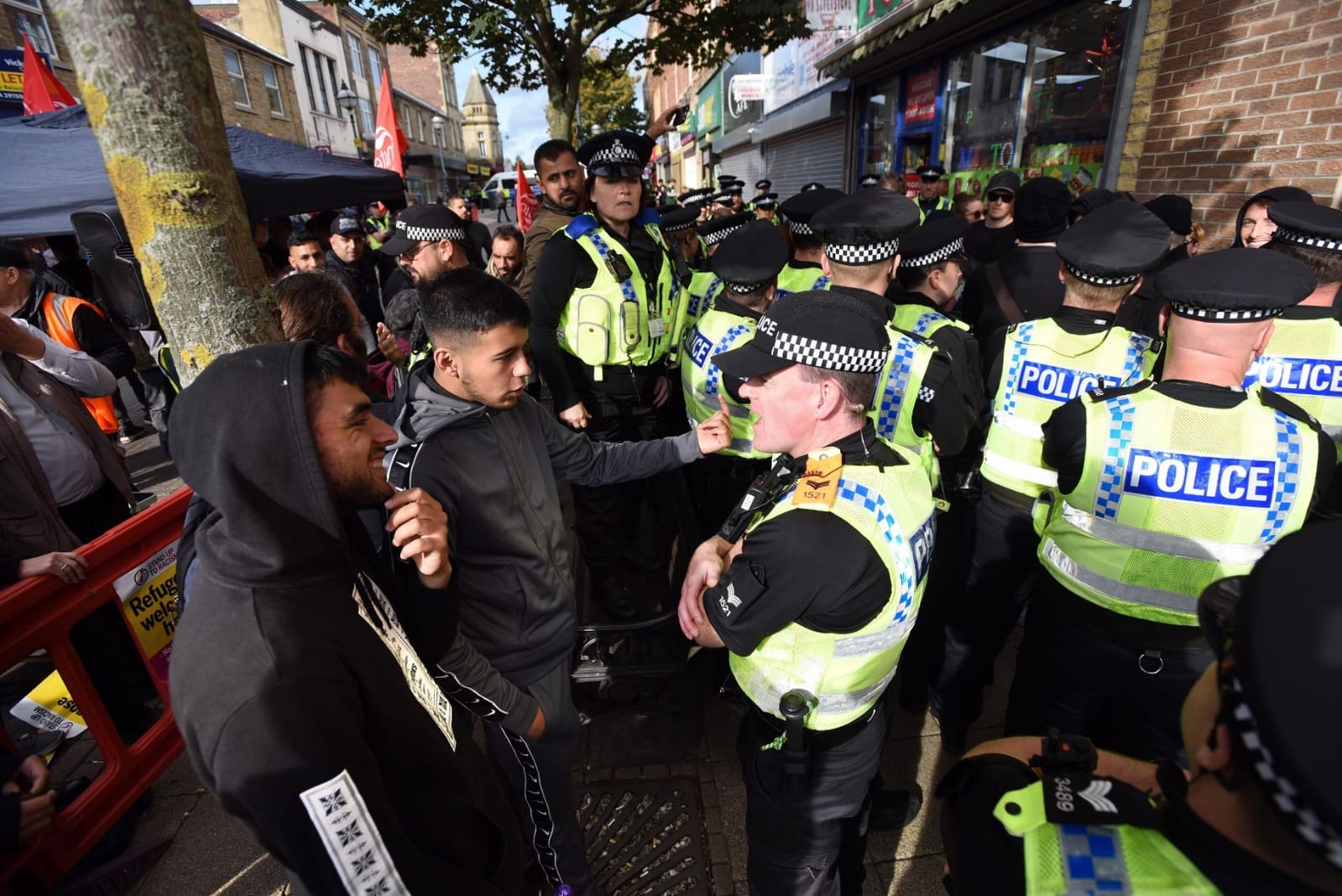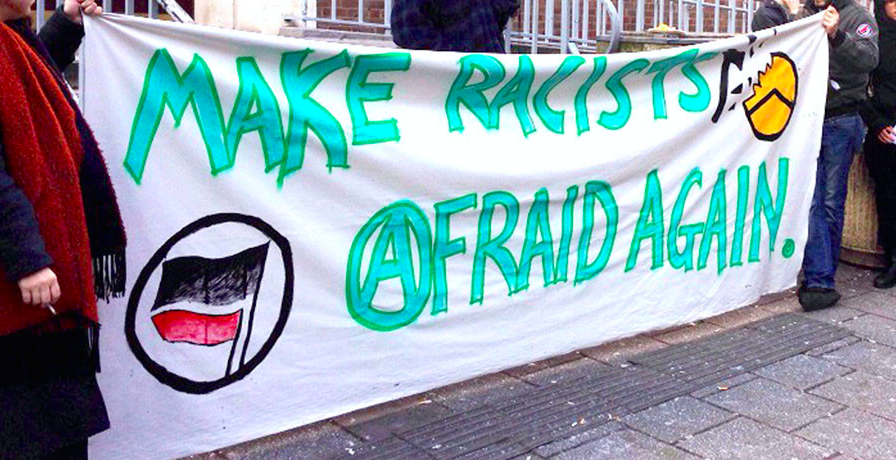Since the fascist terrorist attack against Muslims in Christchurch, New Zealand, we believe that this article is urgent in understanding what fascism is and how to effectively fight against it. Simply labelling the recent fascist attacks as ‘mere anomalies’, or as ‘the acts of singular individuals’, ignores the structural racism and Islamophobia that permeate the lives of certain minorities on a daily basis.
Whilst liberals may push uncritically for debates, or to simply ignore fascists until “they go away”, the historical examples clearly do not bear these opinions out. The obvious examples of fascist states are Nazi Germany and Fascist Italy, where power was taken through a combination of street presence and legal means. Hitler being granted emergency powers by Von Hindenburg in 1933 was contingent not only on Hitler being seen as a strongman who could save the state, but also on the SA’s aggression in the streets. This is true for Mussolini’s rise to dominance in 1922 – the “March on Rome” led to Mussolini seizing power through the strength of his blackshirt militia. In Spain the far right’s ascendancy to rule was through civil war and the the destruction of the left and movements for regional autonomy. The examples of Fascist Italy and Nazi Germany offer us the most important lesson – that we must never let them have the streets.
Fascism (today) has often been considered as non-compatible with British identity, largely because of Britain’s role in the defeat of Fascist Italy and Nazi Germany during the Second World War. However, various proto-fascist, and later outright fascist groupings have coalesced in Britain. Early fascist groups in the UK, like the British Fascisti and Imperial Fascist League, were influenced by Mussolini’s rise to power, but failed to gain much support due to a lack of charismatic leadership. This continued until the British Union of Fascists (BUF), under the leadership of Oswald Mosley, came onto the scene. The BUF attracted 50,000 members, the support of major national newspapers and waged a campaign of terror against Jewish areas in the East End of London. Pushbacks, spearheaded by the Jewish Community and the Communist Party, began, and the BUF suffered major defeats at the Olympia Hall because of its gratuitous use of violence against anti-fascists in 1934 and was utterly routed at the Battle of Cable Street in 1936. Despite this humiliation, the BUF still posed a threat to British Jews, and would continue to do so until the onset of the Second World War, when much of their leadership was interned because of their Nazi sympathies.
However, the end of the Second World War did not end British fascism, and certainly did not curtail anti-semitism in Britain – despite the Nazis’ atrocities. Mosley continued to organise well into the 1960s. The resistance to fascism was led by a group of ex Jewish servicemen known as the 43 Group. Appalled at the anti-semitism of fascist groupings like the League of Ex-Servicemen and Mosley’s Union Movement, they physically attacked fascist meetings and were incredibly effective at checking and halting fascist organising until the formation of the National Front (NF) in 1967.
The NF was founded by AK Chesterton, formerly of the BUF, in 1967. The NF went on to become the country’s fourth largest party, and emulated the BUF’s strategy, itself a copy of Mussolini and Hitler, of “march and grow” – provocative marches through mainly minority areas, such as Lewisham in 1977, to appear strong and grow support in the face of an “alien invasion”. The Battle of Lewisham was a major success for the anti-fascist movement, but would lead to splits – the Socialist Workers Party used the success of Lewisham to argue that the focus should be on the Conservative Party, as the threat of the NF had been fought off. However, the militant “squadists” argued that the threat of violence for Black and Asian families in the East End had not been erased. The squads were kicked out of the SWP, and went on to form Red Action in 1981, an organisation that would play a key part in the formation of Anti-Fascist Action (AFA) who essentially kicked the British National Party (BNP) off the streets.
The BNP was made up of defectors from the NF around John Tyndall, an avowed Neo-Nazi since the 1960s. The BNP emulated the tactics of the NF and BUF, however, in the face of a major militant anti-fascist campaign led by AFA, they withdrew from the “march and grow” tactic of old – “No more marches, punch ups” was the proclamation from the BNP leadership. The BNP went on to become the most successful far right party since the Second World War with its focus on council elections – it was able to gain 50 council seats in local elections. The BNP, in the face of a major anti-racist campaign and various disastrous public appearances, like Nick Griffin’s infamous Question Time appearance, began to flounder and the far right seemed to fade into obscurity again.
The far right in Britain was seemingly insignificant, or so it seemed. However, the English Defence League (EDL) would soon take up the mantle of fascist organising in the UK. Set up by Stephen Yaxley-Lennon (‘Tommy Robinson’), a football hooligan and ex-BNP member from Luton, it denoted a move away from electoral politics and a return to marches. This move, as well as virulent islamophobia, would characterise the “famous” EDL’s rise. What was alarming, however, was the frequency and volume in which the EDL could organise almost everywhere around the country. Another cause for concern about the EDL was the lack of resistance from the left – the first marches were largely opposed by the Muslim communities they were targeting. Ludicrous suggestions of outreach were put forth by the likes of Class War, who failed to see that this was just yet another manifestation of British fascism. The EDL re-created the methods of their predecessors – targeting minority areas for their marches, whereas before it had been Jewish and Black areas, this time the target was mainly Pakistani Muslims who were perceived as a “fifth column” for a “Muslim invasion”. The EDL too eventually saw its decline, again through anti-fascist campaigning. A seemingly reformed Tommy Robinson threw his lot in with the Quilliam foundation, only for this farce to be exposed as he tried and failed to set up a PEGIDA branch in the UK.
The EDL’s decline saw another trough for fascist organising in the UK, but in its wake followed violent neo-nazi formations like the North West Infidels who aligned themselves with National Action. Outwardly Nazi demonstrations like those held in Dover in 2016 were also enabled by the EDL’s islamophobic and fascist rhetoric, allowing clear and unbridled bigotry to descend upon Britain’s streets. Small fascist demonstrations continued, as did anti-fascist opposition to them, until the far right pulled its head above the parapet in the form of the Football Lads Alliance, an “anti-extremism” group, that then held large demonstrations around the trial and arrest of Tommy Robinson in the summer of 2018. Again, the anti-fascist left was seemingly caught short, but – unlike the EDL days – it was able to turn things around through an overwhelmingly succesful counter-demo on 13 October – the Democratic Football Lads Alliance’s demo was blocked decisively. A pro-Brexit demo on the 9th of December again failed to live up to Yaxley-Lennon’s promises of mass numbers.
The far right, over the past few months, seems to have changed strategy. A pathetically puerile attempt to appropriate the anti-austerity Gilets Jaunes movement from the French has been made, although with their numbers getting lower every weekend, for example in Swindon, this seems yet another example of a failed project for the British far right. The far right seems to want to strategize outside London, although it is likely another demo will occur in the city within the next month. A demo was held in Manchester as part of Tommy’s campaign against the BBC, although it remains to be seen what will happen – Robinson is embroiled in legal trouble due to his fondness of doorstepping of journalists and libelling children. Robinson has taken a role in UKIP as part of its utterly predictable swing to the right to truly occupy the space the BNP once held. The leader, Gerard Batten, has been courting the DFLA, who have been acting as security at their marches, and UKIP has seen a recent resurgence in membership numbers because of their explicit support for and incorporation of Robinson into the party. What remains to be seen is whether they will remain an electoral party, or whether it will form some kind of street movement. What we can be assured of, however, especially in the context of botched Brexit negotiations, and in regards to what is happening elsewhere in the world, is that there will be bigger, possibly more violent far right demonstrations in the UK in the near future. These will most likely coalesce around their new Mosley, Tommy Robinson.
Another strand (and we should view the far right as a collection of strands that connect, rather than one cohesive force) of far right organising in the UK is the emergence of Generation Identity (GI), an import from mainland Europe who paint themselves as “identitarian”, an attempt to appropriate identity politics but, this time, for nazis. GI, despite their claims of hating Neo-Nazis, have the most worrying rhetoric of perhaps any far right party in the UK. GI occupy a space that National Action left off after their prescription, minus the overt Neo-Nazism – they are youthful, they have targeted universities because of their alleged proliferation of “cultural Marxism” and they are clearly influenced by the American alt right. Their activities have been limited to stickering, pulling stunts which have included putting Burqas over statues in multiple cities and dyeing a fountain blood red in Bristol. They have also attended the Free Tommy demos in London. GI seem to have retreated back into their hovel for now, apart from their attendance of demos where other fascists can protect them, but their rhetoric is amongst the most dangerous of the British far right. The youthfulness of their movement is also deeply concerning.
What conclusions can be drawn from this? In our opinion, fascism in Britain today has its roots in the BUF and its predecessors, like the British Fascisti, Imperial Fascist League and proto-fascist groups around the Conservative Party prior to this – people who were in the BUF went on to form the NF, people from the NF went on to form the BNP and so on. The tactics of “march and grow”, the archetypal and original fascist tactic perfected by Mussolini and Hitler, has been fairly ubiquitous, meaning that the streets are one of the main, if not the most important, arena for disrupting far right organising. However, the far right can and will use electoral politics to gain power. Hitler, of course, did this in 1933, and the BNP’s change of strategy left much of the anti-fascist movement flummoxed for some time, until Red Action formed the Independent Working Class Association (IWCA) in 1995 in an attempt to disrupt the BNP’s electoral strategy. Certainly, we cannot let them have the streets, but fascists have and will use electoral politics to gain power, and with UKIP’s recent swing to the far right, we must be aware of this danger.
Having navigated ourselves through the history of the far right, we believe that in order to really understand, or at least identify some of the powers that give rise to the far right, it is imperative for us to have a clear theoretical understanding of the far right and where the far right is situated within the ideologically constructed totality. Our aim here is not merely how to fight fascism defensively, but how to build spaces in which the power relations and material conditions that transform people into far right embodying subjects cease to exist.
It is impossible to conceive of the far right without analysing capitalism, as Horkheimer put it in 1939: “Whoever is not prepared to talk about capitalism should also remain silent about fascism”. Therefore, to see where the far right’s ideology lies, it is imperative to analyse the structures that surface the oppressive relations that were engraved by power, or as Gramsci put it “the relations of force”, within the capitalist mode of production. This power is, when expressed by the far right, a crystalised and material force of (status quo) domination, arising conservatively through the ideological subject’s imaginary as a projection of nostalgia.
These relations of force are predominantly expressed through ideological means, mainly by the dominant bourgeois class, through institutions of power exerted upon its subjects. This coerces the subject to naturalise this power by creating a dominant discourse of meaning, vis-à-vis, the far right is but a socially reproduced subject that embodies, expresses and materialises, through any means necessary, the hegemonic power relations within the boundaries of a nation-state.
This naturalisation can be expressed in various ways historically (as history never remains stagnant). Naturalisations can be seen in the defence of an ideologically constructed sexuality, gender performance and divisions, racial and cultural hierarchies, ableism and so on, resulting in the relations of power to thus socially reproduce while legitimising and sustaining a current underlying discourse that exists – that being relations of power reinforcing the dominant ideology.
These ideological expressions become increasingly intelligible by using Althusser’s distinction between the Repressive State Apparatus (RSA) and the Ideological State Apparatus (ISA). The RSA functions primarily on violence; crudely, it is easy to articulate the RSA as there is only one state, one monopoly on violence (within the nation-state). In short, the ‘core’ of the state is violence. It is built and created through it and defended by it. However, the most crucial aspect of the RSA, in our opinion, is that within this ‘core’ of violence, lies the state’s reproduction of the ‘idealised subject’: discipline. Discipline, and obedience through the ideological discourse, is what makes any institution strong – in its extreme expression it materialises in the ideological domination of the subject representing the institution itself: deserters and mutineers are shot.
This expression of ideology within the RSA is what reproduces the RSA. The obedience that the RSA enforces within civic society must be expressed within the RSA institutions, so as for the RSA to legitimise its function of violence. Thus, a reproductive ideology manifests within the totality of relations – the state and its subjects. This subsequently manifests when the ‘people’ demand the reproduction of the ideological narrative of obedience within and outside the RSA; in its extreme: Fascism, the civic defender of its continuation. The state, therefore, trains its subjects to reproduce the same forces that oppress them. It trains its subjects to the logic of the production process.
The state’s power ends at its borders (we won’t dive too deep in analysing the states inherent expansionism, beyond its border control). Thus, for the so-called ‘People’ to adhere to the state, there has to be a creation its imaginary citizen – its idealised subject.
Citizenship might be given to the Other, if the Other remains close enough to the dominant hegemony, yet far enough to never gain hegemony. The Other is a subject-object signifier that does not fit within the ideological imaginary. A brief expression of the British imaginary goes as such: Whiteness being the dominant imaginary, then comes the ‘second-class citizen’, that being Britain’s darker subjects that are to this day identified as immigrants who are subsequently divided into a ‘good-bad’ dualism, and finally the demonisation of the undocumented migrant being portrayed as the invader of the state’s borders, thus disrupting the British imaginary. It is important to note that the ‘Other’ is required for an identity to exist, as identities exist as negativities. The Self-Identity holds within it its negation thereby the Identity has already Othered itself so as for it to solidify.
We can then clearly identify the fascist’s position within the state’s imaginary. Adorno’s Negative Dialectic is characterised as “philosophical materialism that is historical and critical but not dogmatic” also addressed as a take on history that uses “the strength of the [epistemic] subject to break through the deception [Trug] of constitutive subjectivity”. Through this lens of analysis, we identify the subject’s fascistic tendency in history defending their own Subject position within the oppressive structures that coerce them into identifying within the position they so adamantly defend. Identity is nonidentity. It is the ideologically constructed subject (nonidentity) projecting itself upon the externalisation of the Other-object signifier, that is then negated (= nonidentity) and negated again in order to create a symbolic totality of their own ideologically constructed identity.
These subject-object signifiers are variable and can never be fully conceptualised due to their overdetermination, however, we can signify the dominant signifiers of a given ideological space. If object signifiers are variable (depending on ideology), then so is the identity claim. As Mark Fisher put it, “all of this is temporary”.
Using the above as a theoretical lens on the non-identity identity creation, we can then apply this upon the identity creation of the nation-state. The very identity that the far right seeks to defend.
Every nation-state requires its imagined homogenised ‘People’. This homogenisation begins as soon as there is a driving force of an imagined ‘People’ to materially demand of a nationhood, using the state mechanism as the tool that defends the so-called ‘People’. Mouffe argues that this symbolic unities amongst people occur in order to give meaning to the ideologically constructed Other. Once a ‘People’s’ collective identity solidifies, the Other will either be excluded (through violence) or integrated (through erasure). The far right is the citizen-defence of this unity; its obstacle to transcendence. A good example of this far right nationalist unity is presented in Cyprus, where even seemingly so-called progressives who advocate bi-communalist discourse are inherently exclusionary to anyone who does not identify with the Greek-Cypriot and Turkish-Cypriot identity (e.g. Cypriot Armenians, Cypriot Maronites, Latins, Kurds, Turkish, Lebanese, etc.). The reason for a pushing of bi-communalism is precisely that the conceptions of two ethnicized national communities have managed to gain hegemony over their corresponding ‘Peoples’, thereby, Greek and Turkish, as the two antithetical (yet mirrored) positions, can only be reconciled through the re-organisation of a state hegemony corresponding to the unified landscape of post-reunification: the abstracted meta-ethnic ‘Cypriot’ identity, which reconciles ethnic differences over a narrative which that maintains at least a minimum trans-communal common Cypriotness. And there is a clear hegemonic change through state transformation where these identities seem to become much more fluidly-Real, as we can directly see through a genealogical lens that the national identity changes according to the system the state adamantly defends: from milliet to ethnicity, from ethnicity to civic nationality, all of which are based on an abstract imaginary of what it means to identify in a certain way. The far right is the defender of the reactionary state identity creation. Other examples are seen in Turkey, where the existence of Kurdish identity was presented as an existential threat to Turkishness, resulting in state methods of erasure, where the ‘Kurd’ then becomes the ‘Mountain Turk’. When this fails, the far right, in the Turkish case the Grey Wolves, will be the first ones to restore the national psyche from the newly presented threat of the Other. On a state level, a clear example of homogenisation and policies of integration is the 1923 Greco-Turkish population exchanges. This is accompanied by state erasure of history, for example Turkish nationalism denying the Armenian genocide. Thus these popular (national) identities always function negatively based on the reference of the Other. In the UK, the far right has changed its Othering mechanisms, as the state’s ‘enemy’ adapts throughout history, for the same function – its reproduction. The typical example being: no Nazi without a ‘Jew’, no European without the ‘immigrant threat’. A great example of this defence of the imaginary identity is Generation Identity (GI). It lays its foundation on the fascist narrative of what they fear: a morphological ‘great replacement’ by immigration and specifically of what they refer to as the so-called ‘Islamisation’. GI roots itself in the Identitarian movement. A movement that whitewashes Europe’s history, seeing and projecting Europe’s identity as white and Christian, thereby placing their ideological identity creation within the the negativity of the Other. By all means, this does not imply in any way that the Other is at fault for the existence of the subject creation of this hierarchical relationship of domination, on the contrary, it is power that coerces the Other to maintain its Othered position so as for the reproduction of the dominating (white identity). The Other can go their whole life not knowing the Otherness projected upon them, yet they nonetheless will be portrayed as an eternal Other, coercing them to represent everything that is not European. The Non-European is characterised, to quote Fanon, as “insensible to ethics; he represents not only the absence of values, but also the negation of values. He is, let us dare to admit, the enemy of values, and in this sense he is the absolute evil”. Thereby creating the enemy, in the case of GI being the abstract Muslim, they are able to generate their identity, portraying it as an eternal body that has evolved on its own values, representing a monolithic greatness that is now under threat.
The paradox of the identity expressed by the far right is that it is, in fact, too identitarian. If it were just any other identity, the way in which we contradict it is by pointing out the fluidity and historical contingency of every identity. On the contrary, the far-right’s defence of identity in fact, lacks a proper identity. The identity the far-right are willing kill and die for, exists only through the clinging on to a denial of its constitutive Other.
Zizek asks us to imagine an ordinary German citizen in the late ‘20s and early ‘30s. “His social authority, the symbolic order, is telling him that he is a worker, banker, whatever, but nothing functious. What does society want from him? Why is everything going wrong? The way he perceives the situation is that newspapers lie to him. He lost his work because of inflation. He lost all his money in the bank. His moral degradation and so on; so what’s the meaning of this all? So how to solve this problem? Simple. You need to generate an ideological narrative which explains how things went wrong in a society not as a result of the inherent tensions in the development of this society but as the result of a foreign intruder. ‘Things were ok until Jews penetrated our social body. The way to restore the health of our social body is to eliminate the Jews.’”
Therefore, how do we fight against the emergence of the far-right? The first step is to combat any fascist organising in public, without any exceptions. When fascists feel free to organise in public, their discourse becomes normalised and can gain hegemony. This does not necessarily imply that a fascist party will enter electorally into government, although it is not a far-fetched reality at the moment – but that their discourse can gain hegemony within status quo mainstream politics. Furthermore, fascist organising is a threat to the lives of the people they Other/scapegoat, that being predominantly women, non-binary and BAME communities, who experience the first attacks of the far right’s hegemonic materialisations. Finally, it is imperative of the radical left to seek for alternatives. Capitalism presents itself as eternal, thus becoming increasingly impossible to imagine any alternatives to it. The radical left’s task should be to build bridges into imagining a post-capitalist reality, thereby disrupting reactionary narratives, such as that of the far Right, which present itself as a molotov to the establishment whereas in reality it is a mere exasperation of the status quo reproducing itself. We must present new alternatives so as to disrupt any hegemonic ground that the far Right is trying to gain.
Article written by Plan C members Aristidis Shukuroglou and Jacob Elliman





